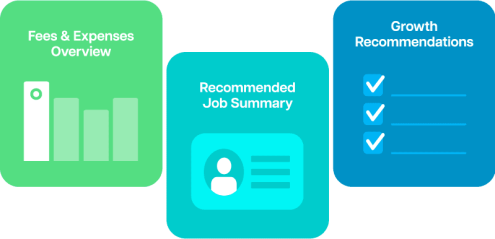Breaking into a global company as a first-time applicant may seem overwhelming, but with the right approach, it’s well within reach. The global job market offers exciting opportunities across various industries, but standing out requires more than just a polished résumé. To secure a role in an international organisation, you’ll need to understand global hiring trends, master cross-cultural communication, and present yourself as a standout candidate.
In this article, we’ll walk you through the steps to confidently navigate the global application process. Whether you’re a recent graduate or a professional aiming for international growth, these practical tips will help you open the door to exciting career opportunities.
Understanding the Global Job Market
To break into a global company, you first need to understand the international job landscape. Global organisations are shaped by changing trends, economic shifts, and specific hiring needs. Researching these factors can give you a competitive edge. Here’s how you can get started:
A. Researching International Companies
Before you submit an application, take time to research the companies you’re targeting. Pay close attention to their global presence, key markets, and workplace culture in different regions. This information will help you tailor your application to meet the specific needs of the role and location.
- Pro Tip: Learn about the company’s corporate social responsibility (CSR) initiatives, partnerships, and expansion plans and ask about it or align it with your goals with the company to stand out in interviews.
B. Trends in Global Hiring
Many international companies are actively hiring in sectors such as technology, finance, health, and digital transformation. Understanding trends in global hiring can help you narrow your job search. Global employers also value candidates with skills such as hybrid work adaptability, problem-solving, and cultural intelligence.
- Emerging Roles: There’s a growing demand for data analysts, cybersecurity professionals, Environmental, Social, and Governance (ESG) experts, and virtual project managers.
C. Industry-Specific Insights
Different industries approach global hiring in their own ways. For example:
- Tech companies often seek candidates with impressive portfolios and open-source contributions.
- Consulting firms prioritise candidates with leadership skills and global mobility.
- Retail and consumer brands value multilingualism and a customer-first approach.
Knowing what your target industry looks for can help you tailor your application and pitch accordingly.
D. Key Global Skills in Demand
Beyond technical know-how, certain soft skills are essential for success in global companies:
- Cultural Adaptability: The ability to work effectively with teams from diverse backgrounds and time zones.
- Collaboration: Global organisations need team players who thrive in collaborative, digital workspaces.
- Language Proficiency: Multilingual candidates often have an edge, especially for roles that involve cross-border communication.
Why It Matters:
The global job market isn’t simply about trends—it’s about positioning yourself as a forward-thinking candidate who meets future organisational needs. Staying informed and tailoring your approach will help you stand out to global employers and showcase your readiness to contribute to their international growth.
Building a Standout Global Résumé and LinkedIn Profile

A well-crafted résumé and LinkedIn profile are crucial for getting noticed by global recruiters. However, it’s not just about listing your accomplishments—it’s about proving that you’re first-class talent ready for international opportunities. Here’s how to create a professional profile that captures global employers’ attention:
A. Writing a Résumé that Opens Doors
Your résumé should highlight your qualifications in a way that resonates with global employers.
- Include International Keywords: Use keywords that reflect global experience, such as “cross-border collaboration”, “remote team management”, or “bilingual communication”.
- Highlight Global Skills: Emphasise soft skills such as cultural sensitivity, adaptability, and language proficiency in both your summary and key achievements.
- Quantify Achievements: Wherever possible, include metrics that demonstrate your impact (e.g., “% increase in global sales” or “coordinated multi-country project rollouts”).
B. Formatting for Global ATS Compatibility
Most international companies use Applicant Tracking Systems (ATS) to screen résumés. To make sure your résumé passes through these digital filters:
- Avoid using graphics, columns, and non-standard fonts.
- Use simple section headers like “Professional Experience”, “Education”, and “Certifications”.
- Stick to ATS-friendly formatting, such as plain bullet points instead of using special symbols.
C. Optimising Your LinkedIn Profile
LinkedIn is an essential platform for international job seekers. Make your profile stand out by:
- Title and Summary: Include your key areas of expertise and the type of global roles you’re seeking. Example: “Project Manager | International Supply Chain Expert | Bilingual (English & Spanish)”.
- Open to Work: Enable the “Open to Work” feature and specify your location preferences (e.g., “Remote”, “Europe”, “APAC region”).
- Experience Section: Highlight your international work, collaborations, and cross-cultural projects.
D. Showcasing Certifications and Language Skills
Here are some sample certifications that demonstrate your expertise in key areas can give you an edge:
- Certifications: PMP (Project Management Professional), Google Analytics, language certifications, or DEI (Diversity, Equity, and Inclusion) training.
- Language Proficiency: If you’re multilingual, create a dedicated section indicating your fluency level (e.g., “Fluent in French (C1)”).
E. Engaging with International Recruiters
Having a strong LinkedIn profile isn’t enough—you need to engage actively. Here’s what you can do:
- Follow Global Companies: Regularly follow and engage with the LinkedIn pages of your target companies.
- Comment on Industry Posts: Share insights or leave thoughtful comments to boost your visibility.
- Direct Outreach: Don’t hesitate to connect with recruiters and hiring managers. Personalise your messages to make a lasting impression.
Why It Matters:
Your résumé and LinkedIn profile are often the first impressions global recruiters have of you. An optimised profile shows you’re ready to succeed in international roles and demonstrates that you’ve taken the time to stand out from other applicants.
Nailing the Application Process

Landing your dream job starts with a strong application that stands out from the competition. Submitting an online application for a global company isn’t as simple as uploading a résumé and clicking “apply”. A strategic approach can help you navigate Applicant Tracking Systems (ATS), showcase your personality, and demonstrate that you’re the perfect fit for the role.
A. Crafting Personalised Cover Letters
A tailored cover letter can set you apart from other candidates:
- Use the Hiring Manager’s Name: Avoid generic greetings like “To whom it may concern”. Instead, research the recruiter or department head’s name.
- Emphasise International Readiness: Mention any experience working with international teams or across time zones.
- Tell a Compelling Story: Share a brief example of how you’ve contributed to a project relevant to the role.
B. Understanding Applicant Tracking Systems (ATS)
Many global companies use ATS software to filter résumés before a human ever reviews them. To improve your chances of passing the ATS:
- Use Job-Specific Keywords: Include key phrases directly from the job description, especially soft and hard skills.
- Avoid Unnecessary Formatting: Use plain text formatting—avoid tables, graphs, or icons that could confuse the system.
- File Type: Submit your résumé as a PDF unless instructed otherwise (some ATS systems only accept .docx).
C. Navigating Global Job Portals
Most global companies post their job openings on platforms such as LinkedIn, Indeed, Glassdoor, and their official websites. Here’s how to use these platforms effectively:
- Set Job Alerts: Most platforms allow you to set alerts for international roles in specific regions or remote positions.
- Track Your Applications: Create a spreadsheet to monitor where and when you applied, follow-ups, and next steps.
- Avoid “One-Click Apply”: Whenever possible, manually complete your application on the company’s website for a more tailored approach.
D. Following Up After Submission
A thoughtful follow-up can leave a positive impression when done correctly:
- Timing Matters: Wait 5–7 business days after submission before following up.
- Professional Follow-Up: Send a concise, polite email or LinkedIn message reiterating your interest in the role.
- Stay Consistent: If there’s no response after another week, it’s acceptable to send a final follow-up before moving on to other opportunities.
E. Leveraging Employee Referral Programmes
Many international companies prioritise applicants who come through employee referrals:
- Find Internal Connections: Use LinkedIn to identify mutual connections with current employees at your target company.
- Ask for a Referral: Be concise and professional when asking for a referral. Share your résumé and the specific role to make it easy for them.
- Respect Boundaries: If someone is unwilling to refer you, thank them and move on without pushing further.
Why It Matters:
The global job application process is highly competitive, but understanding ATS software, crafting compelling cover letters, and using job portals effectively can give you an edge. A tailored application and professional follow-ups show employers that you’re serious about the opportunity, and that level of care can make all the difference.
Cross-Cultural Interviewing
Preparing for an interview is your chance to make a lasting impression and stand out as the ideal candidate. Securing an interview at a global company is an exciting milestone—but excelling in the interview requires more than rehearsing standard questions. Since you’ll be interacting with recruiters and hiring managers from different backgrounds, understanding cross-cultural nuances can significantly boost your chances of success.
A. Preparing for Remote and Video Interviews
Remote interviews have become the norm for global companies. Here’s how to prepare:
- Tech Check: Ensure your camera, microphone, and internet connection are working properly. Familiarise yourself with the interview platform (e.g., Zoom, Microsoft Teams, Google Meet).
- Professional Background: Choose a neutral, clutter-free background with good lighting. Avoid distractions or interruptions.
- Dress Code: Research the company’s culture. While some global firms are casual, others still expect formal or business-casual attire for interviews.
B. Common Questions Global Employers Ask
Global companies often ask questions to gauge your ability to work across cultures. Examples include:
- “Describe a time when you worked with a team from different backgrounds. How did you ensure collaboration?”
- “How do you handle communication challenges when working with international colleagues?”
- “What strategies do you use to stay productive in different time zones?”
Prepare answers that showcase your cross-cultural awareness, problem-solving, and communication skills.
C. Demonstrating Cultural Adaptability
Employers want to see that you can thrive in diverse work environments. You can demonstrate cultural adaptability by:
- Sharing Stories: Provide examples of times you adapted to a new environment or collaborated with a diverse team.
- Demonstrating Open-Mindedness: Show that you’re willing to learn about different work styles and approaches.
- Language Sensitivity: Even if you’re interviewing in your primary language, avoid using slang or colloquialisms that may confuse international recruiters.
D. Addressing Time Zone and Remote Collaboration Challenges
In global roles, coordinating with teams across different time zones is often part of the job. During the interview, you can impress the interviewer by showing you’re prepared for this:
- Time Management: Mention tools or methods you use to manage time zone differences (e.g., shared calendars, time zone apps, or scheduling software).
- Flexibility: Let the interviewer know that you’re willing to adjust your schedule for important team calls or global meetings.
E. Asking Cross-Cultural Questions
Interviews are a two-way street. Asking thoughtful questions demonstrates your interest and readiness to work in a global environment. Examples include:
- “How does the team ensure collaboration across different time zones?”
- “What strategies does the company use to foster cross-cultural communication?”
- “Are there opportunities to work in different regions or participate in cross-border projects?”
Why It Matters:
Cross-cultural interviewing goes beyond answering questions—it’s about demonstrating that you can thrive in a global, diverse environment. By preparing thoroughly, showcasing adaptability, and asking the right questions, you position yourself as a top candidate ready to succeed in international roles.
Expanding Your Network and Finding Mentors

In today’s competitive job market, networking is one of the most effective ways to open doors to new opportunities. Building strong professional relationships is crucial for breaking into global companies. Networking helps you uncover hidden job opportunities, gain insider knowledge, and connect with mentors who can guide your career path. Here’s how you can expand your global network strategically:
A. Using LinkedIn and Alumni Connections
LinkedIn is a powerful tool for building global connections:
- Search for Alumni: Use LinkedIn’s alumni tool to find graduates from your university who work in global companies. Reach out with a polite, personalised message asking for advice.
- Join Professional Groups: Participate in industry-related LinkedIn groups to share insights, join discussions, and connect with professionals worldwide.
- Engage with Content: Comment on and share posts from leaders in your field to increase your visibility and demonstrate your expertise.
B. Joining Global Professional Communities
Many industries have global communities and forums where professionals connect:
- Slack and Discord Communities: Some industries, particularly tech and marketing, have active Slack and Discord groups for global networking.
- Webinars and Virtual Events: Attend international webinars and networking events to meet professionals in your target industry.
- Industry Conferences: Look for virtual and in-person global conferences where you can network with hiring managers and industry experts.
C. Finding and Approaching Mentors
A mentor with global experience can provide invaluable guidance. Here’s how to find one:
- Identify Potential Mentors: Look for professionals whose career paths inspire you, whether they’re LinkedIn connections, former managers, or industry thought leaders.
- Make Your Approach Personal: When reaching out, mention what you admire about their work and ask for a brief chat.
- Respect Their Time: Be clear about what you’re seeking (e.g., a 20-minute meeting or occasional career advice) and show gratitude for their time and insights.
D. Leveraging Informational Interviews
Informational interviews are informal conversations where you learn more about an organisation or career path:
- Ask Insightful Questions: Instead of asking for a job, inquire about the mentor’s experience, team culture, or typical career progression within the company.
- Follow Up: Send a thank-you message and keep in touch occasionally with updates on your progress. Maintaining these connections can lead to referral opportunities.
E. Staying Active and Giving Back
Networking is a two-way street. To build meaningful connections:
- Offer Help: Share relevant articles, job leads, or introductions within your network. Small gestures can strengthen relationships.
- Stay Consistent: Dedicate time each week to engaging with your network—comment on posts, attend events, or send messages.
- Pay It Forward: Once you land a global role, consider mentoring others who are seeking similar opportunities.
Why It Matters:
Networking and mentorship can provide you with access to job leads and insights that aren’t publicly listed. By actively growing your global network and forming connections with mentors, you increase your chances of securing international opportunities while gaining valuable support throughout your career journey.
Conclusion
Breaking into a global company as a first-time applicant is an exciting yet challenging journey. By understanding the global job market, building a standout résumé and LinkedIn profile, mastering the application process, excelling in cross-cultural interviews, and expanding your professional network, you can significantly improve your chances of success.
Global organisations value candidates who demonstrate cultural adaptability, proactive communication, and a commitment to growth. Every step you take—from tailoring your cover letters to connecting with mentors—brings you closer to landing your dream international role.
Take the first step today: update your profile, send that networking request, or apply for the global role you’ve been eyeing. With the right strategy, your global career journey is within reach!
FAQ's
What should I include in my cover letter for a global company?
Your cover letter should be tailored to the specific company and role:
- Address the hiring manager by name if possible.
- Highlight your international experience or demonstrate your ability to work across cultures.
- Share an example that showcases your cultural adaptability and problem-solving skills.
- Express your enthusiasm for contributing to the company’s global success.
How can I make my résumé stand out to global employers?
To stand out:
- Quantify your achievements (e.g., “Increased sales by 20% across three regions”).
- Include job-specific keywords from the job description to improve ATS (Applicant Tracking System) compatibility.
- Showcase any language proficiency, global collaborations, and international certifications (e.g., PMP, language fluency).
Is being multilingual necessary to get a job at a global company?
Not necessarily. While being multilingual is an advantage for many roles, most global companies value:
- Cultural sensitivity and the ability to work well with diverse teams.
- Strong communication skills to collaborate across borders, even if it’s primarily in English.
How do I prepare for a virtual interview with an international company?
- Test your technology beforehand (camera, microphone, internet connection).
- Prepare a quiet, professional space with good lighting.
- Research the company’s dress expectations and dress in business-casual or formal attire as appropriate.
- Be ready to answer cross-cultural questions (e.g., “How do you handle time zone differences?”).
How do I follow up after submitting an international job application?
- Wait 5–7 business days after submitting your application before following up.
- Send a polite, concise email or LinkedIn message reiterating your interest and highlighting a relevant skill or achievement.
- If you don’t receive a response after another week, it’s acceptable to send one final follow-up before moving on to other opportunities.
Final Tip:
If you’re unsure about any part of the application process, seek feedback from a mentor, a career coach, or a trusted professional in your field. The more prepared you are, the more confident you’ll feel as you pursue your dream role at a global company.









